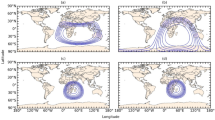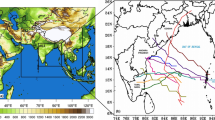Abstract
Tropical cyclones (TCs) are one of the most devastating natural phenomena. This study examines the capability of a global climate model with grid stretching (CAM-EULAG, hereafter CEU) in simulating the characteristics of TCs over the South West Indian Ocean (SWIO). In the study, CEU is applied with a variable increment global grid that has a fine horizontal grid resolution (0.5° × 0.5°) over the SWIO and coarser resolution (1° × 1°—2° × 2.25°) over the rest of the globe. The simulation is performed for the 11 years (1999–2010) and validated against the Joint Typhoon Warning Center (JTWC) best track data, global precipitation climatology project (GPCP) satellite data, and ERA-Interim (ERAINT) reanalysis. CEU gives a realistic simulation of the SWIO climate and shows some skill in simulating the spatial distribution of TC genesis locations and tracks over the basin. However, there are some discrepancies between the observed and simulated climatic features over the Mozambique channel (MC). Over MC, CEU simulates a substantial cyclonic feature that produces a higher number of TC than observed. The dynamical structure and intensities of the CEU TCs compare well with observation, though the model struggles to produce TCs with a deep pressure centre as low as the observed. The reanalysis has the same problem. The model captures the monthly variation of TC occurrence well but struggles to reproduce the interannual variation. The results of this study have application in improving and adopting CEU for seasonal forecasting over the SWIO.












Similar content being viewed by others
References
Abiodun BJ, Prusa JM, Gutowski WJ Jr (2008) Implementation of a non-hydrostatic, adaptive-grid dynamics core in CAM3. Part I: comparison of dynamics cores in aqua-planet simulations. Clim Dyn 31(7–8):795–810
Abiodun BJ, Gutowski WJ, Abatan AA, Prusa JM (2011) CAM-EULAG: a non-hydrostatic atmospheric climate model with grid stretching. Acta Geophys 59(6):1158–1167
Araujo JA, Abiodun BJ, Crespo O (2014) Impacts of drought on grape yields in Western Cape, South Africa. Theoret Appl Climatol, pp 1–14
Badarinath KVS, Mahalakshmim DV, Ratna SB (2012) Influence of land use land cover on cyclone track prediction—a study during Ailia cyclone. Open Atmos Sci J [Online] 6:6 February 2013. Available from: http://benthamopen.com/toascj/articles/V006/33TOASCJ.pdf
Bell GD, Halpert MS, Schnell RC, Higgins RW, Lawrimore J, Kousky VE, Tinker R, Thiaw W, Chelliah M, Artusa A (2000) Climate assessment for 1999. Bull Am Meteorol Soc 81(6):s1–s50
Bell J, Hodges K, Vidale PL, Strachan J, Roberts M (2014) Simulation of the global ENSO–tropical cyclone teleconnection by a high-resolution coupled general circulation model. J Clim [Online] 27(17):14 (November 2014-6404-6422). Available from: http://journals.ametsoc.org/doi/pdf/10.1175/JCLI-D-13-00559.1
Bengtsson L, Botzet M, Esch M (1995) Hurricane-type vortices in a general circulation model. Tellus [Online] 47A(2):175–196. Available from: http://envsci.rutgers.edu/~toine379/extremeprecip/papers/bengtsson_et_al_1995.pdf. 4 Nov 2014
Bengtsson L, Botzet M, Esch M (1996) Will greenhouse gas-induced warming over the next 50 years lead to higher frequency and greater intensity of hurricanes?. Tellus [Online], 4A(1):3 November 2014-57-73. Available from: http://pubman.mpdl.mpg.de/pubman/item/escidoc:1852493:2/component/escidoc:1852573/11632-38420-1-SM.pdf
Berrisford P, Kallberg P, Kobayashi S, Dee D, Uppala S, Simmons A, Poli P, Sato H (2011) The ERA-Interim archive version 2.0. Eur Centre Medium-Range Weather Forecasts ERA Tech Rep 1:23
Caian M, Geleyn JF (1997) Some limits to the variable-mesh solution and comparison with the nested lam solution. Q J R Meteorol Soc 123(539):743–766
Camargo SJ, Sobel AH (2005) Western North Pacific tropical cyclone intensity and ENSO. J Clim 18(15):2996–3006
Chatzidimitriou K, Sutton A (2005) Alternative data mining techniques for predicting tropical cyclone intensification. In: American Association for Artificial Intelligence, vol 37. Citeseer, New Jersey, pp 99–128
Collins WD, Rasch PJ, Boville BA, Hack JJ, McCaa JR, Williamson DL, Kiehl JT, Briegleb B, Bitz C, Lin S (2004) Description of the NCAR community atmosphere model (CAM 3.0)”
Driver P (2014) Rainfall variability over Southern Africa, PhD Thesis Submitted to the University of Cape Town
Dvorak VF (1984) Tropical cyclone intensity analysis using satellite data, US Department of Commerce, National Oceanic and Atmospheric Administration, National Environmental Satellite, Data, and Information Service
Girishkumar MS, Ravichandran M (2012) The influences of ENSO on tropical cyclone activity in the Bay of Bengal during October–December. J Geophys Res 117:C02033. doi:10.1029/2011JC007417
Goerss JS (2000) Tropical cyclone track forecasts using an ensemble of dynamical models. Mon Weather Rev 128(4):1187–1193
Gray WM (1968) “Global view of the origin of tropical disturbances and storms. Mon Weather Rev 96(10):669–700
Gray WM (1979) Hurricanes: their formation, structure, and likely role in the tropical circulation. In: Shaw DB (ed) Meteorology over the Tropical Oceans. Royal meteorological Society, pp 155–218
Hamill TM, Whitaker JS, Fiorino M, Benjamin SG (2011) Global ensemble predictions of 2009’s tropical cyclones initialized with an ensemble Kalman filter. Mon Weather Rev 139(2):668–688
Harris LM, Lin SJ, Tu C (2016) High-resolution climate simulations using GFDL HiRAM with a stretched global grid. J Clim 29(11):4293–4314
Hashimoto A, Done JM, Fowler LD, Bruyère CL (2016) Tropical cyclone activity in nested regional and global grid-refined simulations. Clim Dyn 47(1–2):497–508
Henderson-Sellers A, Zhang H, Berz G, Emanuel K, Gray W, Landsea C, Holland G, Lighthill J, Shieh S, Webster P (1998) Tropical cyclones and global climate change: a post-IPCC assessment. Bull Am Meteorol Soc 79(1):19–38
Holland GJ (1993) Ready reckoner. Glob Guide Trop Cyclone Forecast, pp 9–1
IRIN, Tropical Cyclone Haruna hits southwestern Madagascar. 2015, [Homepage of IRINNews], [Online]. Available: http://www.irinnews.org/report/97542/tropical-cyclone-haruna-hits-southwestern-madagascar [2015, April]
Kleppek S, Muccione V, Raible CC, Bresch DN, Koellner-Heck P, Stocker TF (2008) Tropical cyclones in ERA-40: a detection and tracking method. Geophys Res Lett 35:L10705. doi:10.1029/2008GL033880
Klinman M, Reason C (2008) On the peculiar storm track of TC Favio during the 2006–2007 Southwest Indian Ocean tropical cyclone season and relationships to ENSO. Meteorol Atmos Phys 100(1–4):233–242
Kurowski MJ, Grabowski WW, Smolarkiewicz PS (2014) Anelastic and compressible simulation of moist deep convection. J Atmos Sci V71:3767–3787
Kurowski MJ, Grabowski WW, Smolarkiewicz PS (2015) Anelastic and compressible simulation of moist dynamics at planetary scales. J Atmos Sci, V72:3975–3995
LaRow TE, Lim YK, Shin DW, Chassignet EP, Cocke S (2008) Atlantic basin seasonal hurricane simulations. J Clim 21(13):3191–3206
Manabe S, Holloway JL Jr, Stone HM (1970) Tropical circulation in a time-integration of a global model of the atmosphere. J Atmos Sci 27(4):580–613
Mavume FA, Rydberg L, Rouault M, Lutjeharms REJ (2009) Climatology and landfall of tropical cyclones in the South West Indian Ocean. West Indian Ocean J Mar Sci 8(1):15–36
Mbedzi MP (2010) Simulation of tropical cyclone-like vortices over the southwestern Indian Ocean, University of Pretoria
Misra J (1991) Phase synchronization. Inf Process Lett 38(2):101–105
Morioka Y, Tozuka T, Masson S, Terray P, Luo J, Yamagata T (2012) Subtropical dipole modes simulated in a coupled general circulation model. J Clim 25(12):4029–4047
National Weather Service, Tropical Cyclone Structure. 2010, [Homepage of National Weather Service], [Online]. Available: http://www.srh.noaa.gov/jetstream/tropics/tc_structure.htm?&session-id=e2221f2646ce61f563e3a28f11ec4d98. 2015, July
Ogier D (2013) Characteristics of inertial gravity waves over Southern Africa as simulated with CAM-EULAG, A MSc thesis submitted to the University of Cape Town
Prusa JM, Gutowski WJ (2010) Multi-scale waves in sound-proof global simulations with EULAG. Acta Geophys V59:1135–1157
Rodrigues RR, Campos EJ, Haarsma R (2015) The impact of ENSO on the South Atlantic subtropical dipole mode. J Clim 28(7):2691–2705
Saha KK, Wasimi SA (2013) Interrelationship between Indian Ocean Dipole (IOD) and Australian Tropical Cyclones. Int J Environ Sci Dev 4(6):647
Saji N, Goswami BN, Vinayachandran P, Yamagata T (1999) A dipole mode in the tropical Indian Ocean. Nature 401(6751):360–363
Schenkel BA, Hart RE (2012) An examination of tropical cyclone position, intensity, and intensity life cycle within atmospheric reanalysis datasets. J Clim 25(10):3453–3475. doi:10.1175/2011JCLI4208.1
Schreck CJ III, Knapp KR, Kossin JP (2014) The impact of best track discrepancies on global tropical cyclone climatologies using IBTrACS. Mon Weather Rev 142(10):3881–3899
Strachan J, Vidale PL, Hodges K, Roberts M, Demory M (2013) Investigating global tropical cyclone activity with a hierarchy of AGCMs: The role of model resolution. J Clim [Online] 26(1):5 November-133-152. Available from: http://journals.ametsoc.org/doi/pdf/10.1175/JCLI-D-12-00012.1
Tozuka T, Abiodun BJ, Engelbrecht FA (2014) Impacts of convection schemes on simulating tropical-temperate troughs over southern Africa. Clim Dyn 42(1–2):433–451
Vitart F, Anderson J, Stern W (1997) Simulation of interannual variability of tropical storm frequency in an ensemble of GCM integrations. J Clim 10(4):745–760
Vitart F, Anderson D, Stockdale T (2003) Seasonal forecasting of tropical cyclone landfall over Mozambique. J Clim 16(23):3932–3945
Walsh K, Fiorino M, Landsea C, McInnes K (2007) Objectively determined resolution-dependent threshold criteria for the detection of tropical cyclones in climate models and reanalyses. J Clim 20(10):2307–2314
Walsh KE, Camargo SJ, Vecchi GA, Daloz A, Elsner J, Emanuel K, Horn M, Lim Y, Roberts M, Patricola C, Scoccimarro E, Sobel AH, Strazzo S, Villarini G, Wehner M, Zhao M, Kossin JP, LaRow T, Oouchi K, Schubert S, Wang H, Bacmeister J, Chang P, Chauvin F, Jablonowski C, Kumar A, Murakami H, Ose T, Reed KA, Saravanan R, Yamada Y, Zarzycki CM, Vidale P, Jonas JA, Henderson N (2015) Hurricanes and climate: the U.S. CLIVAR working group on hurricanes. Bull Am Meteorol Soc 96:997–1017. doi:10.1175/BAMS-D-13-00242.1
Williamson DL (2008) Convergence of aqua-planet simulations with increasing resolution in the Community Atmospheric Model, Version3. Tellus 60A:848–862
Zarzycki CM, Jablonowski C (2014) A multidecadal simulation of Atlantic tropical cyclones using a variable resolution global atmospheric general circulation model. J Adv Model Earth Syst 6(3):805–828
Zarzycki CM, Jablonowski C, Taylor MA (2014) Using variable-resolution meshes to model tropical cyclones in the Community Atmosphere Model. Mon Weather Rev 142(3):1221–1239
Zhao M, Held IM (2012) TC-Permitting GCM simulations of hurricane frequency response to sea surface temperature anomalies projected for the late-twenty-first century. J Clim [Online] 24(8):15 (November 2014-2995-3009). Available from: http://journals.ametsoc.org/doi/pdf/10.1175/JCLI-D-11-00313.1
Acknowledgements
The project was supported with grants and bursaries from National Research Foundation (NRF, South Africa), Water Research Commission (WRC, South Africa), and the Future Resilience for African Cities and Lands (FRACTAL) project. Computing facility was provided by Centre for High Performance Computing (CHPC, South Africa). We thank the two anonymous reviewers, whose comments have helped in improving the quality of the manuscript.
Author information
Authors and Affiliations
Corresponding author
Rights and permissions
About this article
Cite this article
Maoyi, M.L., Abiodun, B.J., Prusa, J.M. et al. Simulating the characteristics of tropical cyclones over the South West Indian Ocean using a Stretched-Grid Global Climate Model. Clim Dyn 50, 1581–1596 (2018). https://doi.org/10.1007/s00382-017-3706-x
Received:
Accepted:
Published:
Issue Date:
DOI: https://doi.org/10.1007/s00382-017-3706-x




